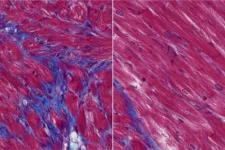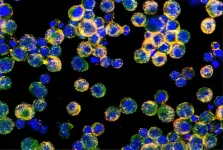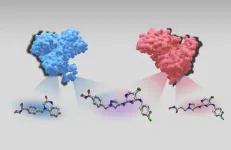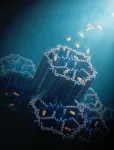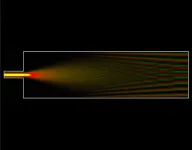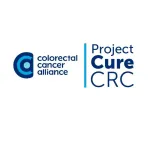(Press-News.org) A new study from Washington University School of Medicine in St. Louis suggests that a type of immunotherapy — similar to that approved by the Food and Drug Administration (FDA) to treat inflammatory conditions such as arthritis — also may be an effective treatment strategy for heart failure.
The study is published Oct. 23 in the journal Nature.
After a heart attack, viral infection or other injury to the heart, scar tissue often forms in the heart muscle, where it interferes with the heart’s normal contractions and plays a leading role in heart failure, the progressive loss of the heart’s ability to pump sufficient blood to the body. This chronic condition creates a worsening feedback loop that can only be slowed with available medical therapies, but it has no cure.
Studying human tissue samples as part of the new study, the researchers identified a type of fibroblast cell in the heart as the main culprit responsible for the formation of scar tissue in heart failure. To see if they could prevent scar formation, the scientists turned to mouse models of heart failure that have the very same type of fibroblasts. They used a therapeutic protein — called a monoclonal antibody — that blocks the formation of this harmful type of fibroblast, and succeeded in reducing the formation of scar tissue and improving heart function in the mice.
“After scar tissue forms in the heart, its ability to recover is dramatically impaired or impossible,” said cardiologist and senior author Kory Lavine, MD, PhD, a professor of medicine in the Cardiovascular Division at WashU Medicine. “Heart failure is a growing problem in the U.S. and globally, affecting millions of people. Current treatments can help relieve symptoms and slow the progression, but there is a tremendous need for better therapies that actually stop the disease process and prevent the formation of new scar tissue that causes a loss of heart function. We are hopeful our study will lead to clinical trials investigating this immunotherapy strategy in heart failure patients.”
Fibroblasts have many roles in the heart, and parsing out the differences between various populations of these cells has been challenging. Some types of fibroblasts support the heart’s structural integrity and maintain good blood flow through the heart’s blood vessels, while others are responsible for driving inflammation and the development of scar tissue. Only recently, with the wide availability of the most advanced single cell sequencing technologies, could scientists peg which groups of cells are which.
“These various types of fibroblasts highlight newly recognized opportunities to craft treatment strategies that specifically block the type of fibroblasts that promote scarring and protect fibroblasts that maintain the structure of the heart, so the heart doesn’t rupture,” Lavine said. “Our research suggests that the fibroblasts that promote scarring in the injured heart are very similar to fibroblasts associated with cancer and other inflammatory processes. This opens the door to immunotherapies that potentially can stop the inflammation and resulting scar tissue.”
The research team, co-led by Junedh Amrute, a graduate student in Lavine’s lab, used genetic methods to demonstrate that a signaling molecule called IL-1 beta was important in a chain of events driving fibroblasts to create scar tissue in heart failure. With that in mind, they tested a mouse monoclonal antibody that blocks IL-1 beta and found beneficial effects in the mouse hearts. The mouse monoclonal antibody was provided by Amgen, whose scientists were also co-authors of the study. Monoclonal antibodies are proteins manufactured in the lab that modulate the immune system. The treatment reduced the formation of scar tissue and improved the pumping capacity of the mouse hearts, as measured on an echocardiogram.
At least two FDA-approved monoclonal antibodies — canakinumab and rilonacept — can block IL-1 signaling. These immunotherapies are approved to treat inflammatory disorders such as juvenile idiopathic arthritis and recurrent pericarditis, which is inflammation of the sac surrounding the heart.
One of these antibodies also has been evaluated in a clinical trial for atherosclerosis, a buildup of plaque that hardens the arteries. The trial, called CANTOS (Canakinumab Anti-inflammatory Thrombosis Outcome Study), showed a benefit for study participants with atherosclerosis.
“Even though this trial was not designed to test this treatment in heart failure, there are hints in the data that the monoclonal antibody might be beneficial for patients with heart failure,” Lavine said. “Secondary analyses of the data from this trial showed that the treatment was associated with a sizable reduction in heart failure admissions compared with standard care. Our new study may help explain why.”
Even so, the IL-1 antibody used in the CANTOS study had some side effects, such as increased risk of infection, that could perhaps be reduced with a more targeted antibody that specifically blocks IL-1 signaling in cardiac fibroblasts, according to the researchers.
“We are hopeful that the combination of all of this evidence, including our work on the IL-1 beta pathway, will lead to the design of a clinical trial to specifically test the role of targeted immunotherapy in heart failure patients,” Lavine said.
Amrute JM, Luo X, Penna V, Yang S, Yamawaki T, Hayat S, Bredemeyer A, Jung I, Kadyrov FF, Seong Heo G, Vankatesan R, Yu Shi S, Parvathaneni A, Koenig AL, Kue C, Baker C, Luehmann H, Jones C, Kopecky B, Zeng X, Blekwehl T, Ma P, Lee P, Terada Y, Fu A, Furtado M, Kreisel D, Kovacs A, Stitziel NO, Jackson S, Li C, Liu Y, Rosenthal NA, Kramann R, Ason B, Lavine KJ. Targeting immune fibroblast cell communication in heart failure. Nature. Oct. 23, 2024. DOI: 10.1038/s41586-024-08008-5.
This work was supported by by the National Institutes of Health (NIH), grant numbers R01 HL138466, R01 HL139714, R01 HL151078, R01 HL161185, R35 HL161185, R35HL145212, P41EB025815, P30CA91842 and P30AR073752; the Leducq Foundation Network, #20CVD02; Sponsored Research Agreement from Amgen; the Burroughs Welcome Fund, grant number 1014782; the American Heart Association Predoctoral Fellowship, grant number 826325; the Children’s Discovery Institute of Washington University and St. Louis Children’s Hospital, grant numbers CH-II-2015-462, CH-II-2017-628, PM-LI-2019-829; The Foundation for Barnes-Jewish Hospital, grant number 8038-88; and Washington University School of Medicine. The content is solely the responsibility of the authors and does not necessarily represent the official views of the NIH.
About Washington University School of Medicine
WashU Medicine is a global leader in academic medicine, including biomedical research, patient care and educational programs with 2,900 faculty. Its National Institutes of Health (NIH) research funding portfolio is the second largest among U.S. medical schools and has grown 56% in the last seven years. Together with institutional investment, WashU Medicine commits well over $1 billion annually to basic and clinical research innovation and training. Its faculty practice is consistently within the top five in the country, with more than 1,900 faculty physicians practicing at 130 locations and who are also the medical staffs of Barnes-Jewish and St. Louis Children’s hospitals of BJC HealthCare. WashU Medicine has a storied history in MD/PhD training, recently dedicated $100 million to scholarships and curriculum renewal for its medical students, and is home to top-notch training programs in every medical subspecialty as well as physical therapy, occupational therapy, and audiology and communications sciences.
END
Immunotherapy blocks scarring, improves heart function in mice with heart failure
Antibody that reduces inflammation could serve as cardio-immunotherapy for heart failure patients
2024-10-23
ELSE PRESS RELEASES FROM THIS DATE:
Discovery finds how ovarian cancer disables immune cells
2024-10-23
Weill Cornell Medicine researchers have discovered a mechanism that ovarian tumors use to cripple immune cells and impede their attack—blocking the energy supply T cells depend on. The work, published Oct. 23 in Nature, points toward a promising new immunotherapy approach for ovarian cancer, which is notoriously aggressive and hard to treat.
A significant obstacle in treating ovarian cancer is the tumor microenvironment—the complex ecosystem of cells, molecules and blood vessels that shields cancer cells from the immune system. Within this hostile environment, T cells lose their ability to take up the lipid (fat) molecules, which are necessary for energy to mount ...
Physicists discover first “black hole triple”
2024-10-23
Many black holes detected to date appear to be part of a pair. These binary systems comprise a black hole and a secondary object — such as a star, a much denser neutron star, or another black hole — that spiral around each other, drawn together by the black hole’s gravity to form a tight orbital pair.
Now a surprising discovery is expanding the picture of black holes, the objects they can host, and the way they form.
In a study appearing in Nature, physicists at MIT and Caltech report that they have observed a “black hole triple” for the first time. The new system holds a central black hole in the act of consuming a small star ...
A “chemical ChatGPT” for new medications
2024-10-23
Researchers from the University of Bonn have trained an AI process to predict potential active ingredients with special properties. Therefore, they derived a chemical language model – a kind of ChatGPT for molecules. Following a training phase, the AI was able to exactly reproduce the chemical structures of compounds with known dual-target activity that may be particularly effective medications. The study has now been published in Cell Reports Physical Science. Do not publish before Wednesday, October 23rd, 5:00 pm CEST!
Anyone ...
Soteria Precision Medicine Foundation partners with Translational Genomics Research Institute (TGen) to inform cancer care for Special Operations Forces
2024-10-23
PHOENIX, AZ (Oct. 23, 2024) — Soteria Precision Medicine Foundation, a non-profit organization dedicated to providing leading-edge patient precision medicine navigation services to individuals with cancer diagnoses, today announced a partnership with the Translational Genomics Research Institute (TGen), part of City of Hope, to provide precision medicine navigation for Special Operation Forces in their battle against cancer.
Through the strategic agreement with TGen, Soteria will deploy, and scale precision medicine navigation capabilities tailored to meet the unique needs of Special Operation Forces (SOF) members ...
Capturing carbon from the air just got easier
2024-10-23
Capturing and storing the carbon dioxide humans produce is key to lowering atmospheric greenhouse gases and slowing global warming, but today's carbon capture technologies work well only for concentrated sources of carbon, such as power plant exhaust. The same methods cannot efficiently capture carbon dioxide from ambient air, where concentrations are hundreds of times lower than in flue gases.
Yet direct air capture, or DAC, is being counted on to reverse the rise of CO2 levels, which have reached 426 parts per million (ppm), 50% higher than ...
Ultra-small spectrometer yields the power of a 1,000 times bigger device
2024-10-23
Spectrometers are technology for reading light that date back to the era of famed 17th-century physicist Isaac Newton. They work by breaking down light waves into their different colors — or spectra — to provide information about the makeup of the objects being measured.
UC Santa Cruz researchers are designing new ways to make spectrometers that are ultra-small but still very powerful, to be used for anything from detecting disease to observing stars in distant galaxies. Their inexpensive production cost makes them more accessible and customizable for specific applications.
The team of researchers, led by an interdisciplinary ...
Rocky planets orbiting small stars could have stable atmospheres needed to support life
2024-10-23
Since its launch in late 2021, NASA’s James Webb Space Telescope has raised the possibility that we could detect signs of life on exoplanets, or planets outside our solar system.
Top candidates in this search are rocky, rather than gaseous, planets orbiting low-mass stars called M-dwarfs — easily the most common stars in the universe. One nearby M-dwarf is TRAPPIST-1, a star about 40 light years away that hosts a system of orbiting planets under intense scrutiny in the search for life on planets orbiting stars other than the sun.
Previous research questioned the habitability of planets orbiting TRAPPIST-1, finding that intense UV rays would burn away their ...
A 'worrying confluence' of flood risk, social vulnerability and climate change denial
2024-10-23
In certain parts of the United States, especially Appalachia, New England and the Northwest, the ability of residents to prepare for and respond to flooding is being undercut on three different levels.
This is according to a new study from the University of Michigan's School for Environment and Sustainability.
"It's a very worrying confluence that does keep me up," said Joshua Newell, a professor with the school's Center for Sustainable Systems and senior author of the study. "The communities that are most at risk of catastrophic flooding ...
Saving the bats: Researchers find bacteria, fungi on bat wings that could help fight deadly white-nose syndrome
2024-10-23
Saving the bats: Researchers find bacteria, fungi on bat wings that could help fight deadly white-nose syndrome
Hamilton, ON, Oct. 23, 2024 – Bacteria and fungi from the wings of bats could play a significant role in saving them from white-nose syndrome (WNS), a fungal disease affecting the skin of wings and muzzle, which has nearly wiped out vulnerable bat populations across North America.
Researchers at McMaster University have gathered and analyzed samples from the community of microorganisms, or microbiome, on the wings of several bat species ...
Project Cure CRC awards nearly $5 million in research funding
2024-10-23
Washington, D.C. – October 23, 2024 – Project Cure CRC, the breakthrough research fund of the leading nonprofit Colorectal Cancer Alliance (Alliance), has announced five new awardees of funds to advance urgent science in the colorectal cancer space. To date, 10 research grants have been awarded for a grand total of almost $5 million in critically needed funding.
Recipients of the most recent grants totaling almost $1 million include investigators from the University of California, San Francisco, Indiana University, University of Saskatchewan, Georgetown University, and Anglia Ruskin University. ...
LAST 30 PRESS RELEASES:
New expert guidance urges caution before surgery for patients with treatment-resistant constipation
Solar hydrogen can now be produced efficiently without the scarce metal platinum
Sleeping in on weekends may help boost teens’ mental health
Study: Teens use cellphones for an hour a day at school
After more than two years of war, Palestinian children are hungry, denied education and “like the living dead”
The untold story of life with Prader-Willi syndrome - according to the siblings who live it
How the parasite that ‘gave up sex’ found more hosts – and why its victory won’t last
When is it time to jump? The boiling frog problem of AI use in physics education
Twitter data reveals partisan divide in understanding why pollen season's getting worse
AI is quick but risky for updating old software
Revolutionizing biosecurity: new multi-omics framework to transform invasive species management
From ancient herb to modern medicine: new review unveils the multi-targeted healing potential of Borago officinalis
Building a global scientific community: Biological Diversity Journal announces dual recruitment of Editorial Board and Youth Editorial Board members
Microbes that break down antibiotics help protect ecosystems under drug pollution
Smart biochar that remembers pollutants offers a new way to clean water and recycle biomass
Rice genes matter more than domestication in shaping plant microbiomes
Ticking time bomb: Some farmers report as many as 70 tick encounters over a 6-month period
Turning garden and crop waste into plastics
Scientists discover ‘platypus galaxies’ in the early universe
Seeing thyroid cancer in a new light: when AI meets label-free imaging in the operating room
Neutrophil-to-lymphocyte ratio may aid risk stratification in depressive disorder
2026 Seismological Society of America Annual Meeting
AI-powered ECG analysis offers promising path for early detection of chronic obstructive pulmonary disease, says Mount Sinai researchers
GIMM uncovers flaws in lab-grown heart cells and paves the way for improved treatments
Cracking the evolutionary code of sleep
Medications could help the aging brain cope with surgery, memory impairment
Back pain linked to worse sleep years later in men over 65, according to study
CDC urges ‘shared decision-making’ on some childhood vaccines; many unclear about what that means
New research finds that an ‘equal treatment’ approach to economic opportunity advertising can backfire
Researchers create shape-shifting, self-navigating microparticles
[Press-News.org] Immunotherapy blocks scarring, improves heart function in mice with heart failureAntibody that reduces inflammation could serve as cardio-immunotherapy for heart failure patients
